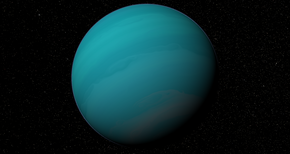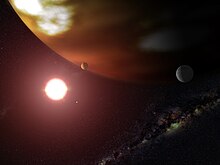Gliese 876 b
 An artist's impression of Gliese 876 b | |
| Discovery[1][2][3] | |
|---|---|
| Discovered by | California and Carnegie Planet Search Teamand independently by theGeneva Extrasolar Planet Search Team |
| Discovery site | Lick,Keck,Haute-ProvenceandLa Silla Observatories |
| Discovery date | June 22, 1998 |
| Doppler spectroscopy | |
| Orbital characteristics[4] | |
| Epoch2,450,602.09311BJD | |
| 0.218627±0.000017AU | |
| Eccentricity | 0.0325+0.0016 −0.0017 |
| 61.1057±0.0074 d | |
| 340.6+4.4 −4º | |
| Inclination | 53.06±0.85 º[note 1] |
| 35.5+4.1 −4.4º | |
| Semi-amplitude | 211.57+0.3 −0.29m/s |
| Star | Gliese 876 |
| Physical characteristics[4] | |
| Mass | 845.2+9.5 −9.4M🜨[note 2] |
| Temperature | 194 K (−79 °C; −110 °F)[5] |
Gliese 876 bis anexoplanetorbitingthered dwarfGliese 876.It completes one orbit in approximately 61days.Discovered in June 1998, Gliese 876 b was the firstplanetto be discovered orbiting ared dwarf.
Discovery[edit]
Gliese 876 b was initially announced byGeoffrey Marcyon June 22, 1998 at a symposium of theInternational Astronomical UnioninVictoria, British Columbia,Canada. The discovery was made using data from theKeckandLick observatories.[3][6]Only 2 hours after his announcement, he was shown an e-mail from theGeneva Extrasolar Planet Searchteam confirming the planet. The Geneva team used telescopes at theHaute-Provence Observatoryin France and theEuropean Southern ObservatoryinLa Serena, Chile.[3][2]Like the majority of early extrasolar planet discoveries it was discovered by detecting variations in its star'sradial velocityas a result of the planet'sgravity.This was done by making sensitive measurements of theDoppler shiftof thespectral linesof Gliese 876. It was the first discovered of four known planets in the Gliese 876 system.[7][1][2][8][9]
Characteristics[edit]
Mass, radius, and temperature[edit]

Given the planet's high mass, it is likely that Gliese 876 b is agas giantwith nosolidsurface. Since the planet has only been detected indirectly through its gravitational effects on the star, properties such as itsradius,composition, andtemperatureare unknown. Assuming a composition similar toJupiterand an environment close tochemical equilibrium,it is predicted that the atmosphere of Gliese 876 b iscloudless,though cooler regions of the planet may be able to formwaterclouds.[10]
A limitation of the radial velocity method used to detect Gliese 876 b is that only a lower limit on the planet'smasscan be obtained. This lower limit is around 1.93 times the mass ofJupiter.[8]Thetrue massdepends on theinclinationof the orbit, which in general is unknown. However, because Gliese 876 is only 15light yearsfrom Earth Benedict et al. (2002) were able to use one of theFine Guidance Sensorson theHubble Space Telescopeto detect theastrometricwobble created by Gliese 876 b.[11]This constituted the first unambiguous astrometric detection of an extrasolar planet.[7]Their analysis suggested that the orbital inclination is 84°±6° (close to edge-on).[11]In the case of Gliese 876 b, modelling the planet-planet interactions from the Laplace resonance shows that the actual inclination of the orbit is 59°, resulting in a true mass of 2.2756 times the mass of Jupiter.[7]
Theequilibrium temperatureof Gliese 876 b, is estimated to be around 194 K (−79 °C; −110 °F).[5]
This planet, like c and e, has likely migrated inward.[12]
Host star[edit]
The planet orbits a (M-type)starnamedGliese 876.The star has a mass of 0.33M☉and a radius of around 0.36R☉.It has a surface temperature of 3350Kand is 2.55 billion years old. In comparison, the Sun is about 4.6 billion years old[13]and has a surface temperature of 5778 K.[14]
Orbit[edit]

Gliese 876 b is in a 1:2:4Laplace resonancewith the inner planetGliese 876 cand the outer planetGliese 876 e:in the time it takes planet e to complete one orbit, planet b completes two and planet c completes four. This is the second known example of a Laplace resonance, the first beingJupiter'smoonsIo,EuropaandGanymede.[7]As a result, theorbital elementsof the planets change fairly rapidly as they dynamically interact with one another.[15]The planet's orbit has a loweccentricity,similar to the planets in theSolar System.Thesemimajor axisof the orbit is only 0.208AU,less than that ofMercuryin the Solar System.[7]However Gliese 876 is such a faintstarthat this puts it in the outer part of thehabitable zone.[16]
Future habitability[edit]
Gliese 876 b currently lies beyond the outer edge of the habitable zone but because Gliese 876 is a slowly evolving main-sequence red dwarf its habitable zone is very slowly moving outwards and will continue to do so for trillions of years. Therefore, Gliese 876 b will, in trillions of years time, lie inside Gliese 876's habitable zone, as defined by the ability of anEarth-mass planet to retainliquidwater at its surface, and remain there for at least 4.6 billion years.[17]While the prospects forlifeon a gas giant are unknown, largemoonsmay be able to support ahabitableenvironment. Models oftidalinteractions between a hypothetical moon, the planet and the star suggest that large moons should be able to survive in orbit around Gliese 876 b for the lifetime of the system.[18]On the other hand, it is unclear whether such moons could form in the first place.[19]However, the large mass of the gas giant may make it more likely for larger moons to form.[citation needed]
For a stable orbit the ratio between the moon'sorbital periodPsaround its primary and that of the primary around its starPpmust be < 1/9, e.g. if a planet takes 90 days to orbit its star, the maximum stable orbit for a moon of that planet is less than 10 days.[20][21]Simulations suggest that a moon with an orbital period less than about 45 to 60 days will remain safely bound to a massive giant planet orbrown dwarfthat orbits 1AUfrom a Sun-like star.[22]In the case of Gliese 876 b, the orbital period would have to be no greater than a week (7 days) in order to have a stable orbit.
Tidal effects could also allow the moon to sustainplate tectonics,which would cause volcanic activity to regulate the moon's temperature[23][24]and create ageodynamo effectwhich would give the satellite a strongmagnetic field.[25]
To support an Earth-like atmosphere for about 4.6 billion years (the age of the Earth), the moon would have to have a Mars-like density and at least a mass of 0.07ME.[26]One way to decrease loss fromsputteringis for the moon to have a strongmagnetic fieldthat can deflectstellar windand radiation belts. NASA'sGalileo'smeasurements hints large moons can have magnetic fields; it found thatJupiter's moonGanymedehas its own magnetosphere, even though its mass is only 0.025ME.[22]
See also[edit]
Notes[edit]
References[edit]
- ^abMarcy, Geoffrey W.; et al. (1998)."A Planetary Companion to a Nearby M4 Dwarf, Gliese 876".The Astrophysical Journal Letters.505(2): L147–L149.arXiv:astro-ph/9807307.Bibcode:1998ApJ...505L.147M.doi:10.1086/311623.
- ^abcDelfosse, Xavier; Forveille, Thierry; Mayor, Michel; Perrier, Christian; Naef, Dominique; Queloz, Didier (1998). "The closest extrasolar planet. A giant planet around the M4 dwarf GL 876".Astronomy and Astrophysics.338:L67–L70.arXiv:astro-ph/9808026.Bibcode:1998A&A...338L..67D.
- ^abc"Astronomers find planet orbiting nearby star"(Press release). W. M. Keck Observatory. 1998-06-22.Archivedfrom the original on 2018-09-24.Retrieved2018-09-23.
- ^abMillholland, Sarah; et al. (2018)."New Constraints on Gliese 876—Exemplar of Mean-motion Resonance".The Astronomical Journal.155(3). Table 4.arXiv:1801.07831.Bibcode:2018AJ....155..106M.doi:10.3847/1538-3881/aaa894.
- ^ab"Archived copy".Archivedfrom the original on 2016-08-19.Retrieved2016-08-03.
{{cite web}}:CS1 maint: archived copy as title (link) - ^Boss, Alan(2009-02-01).The Crowded Universe: The Race to Find Life Beyond Earth.Basic Books. p. 53.ISBN978-0-465-00936-7.
- ^abcdeRivera, Eugenio J.; et al. (July 2010)."The Lick-Carnegie Exoplanet Survey: A Uranus-mass Fourth Planet for GJ 876 in an Extrasolar Laplace Configuration".The Astrophysical Journal.719(1): 890–899.arXiv:1006.4244.Bibcode:2010ApJ...719..890R.doi:10.1088/0004-637X/719/1/890.
- ^abRivera, Eugenio J.; et al. (2005)."A ~7.5 M🜨Planet Orbiting the Nearby Star, GJ 876 ".The Astrophysical Journal.634(1): 625–640.arXiv:astro-ph/0510508.Bibcode:2005ApJ...634..625R.doi:10.1086/491669.
- ^Marcy, Geoffrey W.; et al. (2001)."A Pair of Resonant Planets Orbiting GJ 876".The Astrophysical Journal.556(1): 296–301.Bibcode:2001ApJ...556..296M.doi:10.1086/321552.
- ^Sudarsky, David; et al. (2003)."Theoretical Spectra and Atmospheres of Extrasolar Giant Planets".The Astrophysical Journal.588(2): 1121–1148.arXiv:astro-ph/0210216.Bibcode:2003ApJ...588.1121S.doi:10.1086/374331.
- ^abBenedict, G. F; et al. (2002)."A Mass for the Extrasolar Planet Gliese 876b Determined from Hubble Space Telescope Fine Guidance Sensor 3 Astrometry and High-Precision Radial Velocities".The Astrophysical Journal.581(2): L115–L118.arXiv:astro-ph/0212101.Bibcode:2002ApJ...581L.115B.doi:10.1086/346073.
- ^Gerlach, Enrico; Haghighipour, Nader (2012). "Can GJ 876 host four planets in resonance?".Celestial Mechanics and Dynamical Astronomy.113(1): 35–47.arXiv:1202.5865.Bibcode:2012CeMDA.113...35G.doi:10.1007/s10569-012-9408-0.S2CID119210665.
- ^Fraser Cain (16 September 2008)."How Old is the Sun?".Universe Today.Archivedfrom the original on 18 August 2010.Retrieved19 February2011.
- ^Fraser Cain (September 15, 2008)."Temperature of the Sun".Universe Today.Archivedfrom the original on 29 August 2010.Retrieved19 February2011.
- ^Butler, R. P.; et al. (2006)."Catalog of Nearby Exoplanets".The Astrophysical Journal.646(1): 505–522.arXiv:astro-ph/0607493.Bibcode:2006ApJ...646..505B.doi:10.1086/504701.
- ^Jones, Barrie W.; et al. (2005)."Prospects for Habitable" Earths "in Known Exoplanetary Systems".The Astrophysical Journal.622(2): 1091–1101.arXiv:astro-ph/0503178.Bibcode:2005ApJ...622.1091J.doi:10.1086/428108.
- ^Kasting, James F.; et al. (1993)."Habitable Zones around Main Sequence Stars"(PDF).Icarus.101(1): 108–128.Bibcode:1993Icar..101..108K.doi:10.1006/icar.1993.1010.PMID11536936.Archived(PDF)from the original on 2014-04-07.Retrieved2012-08-05.
- ^Barnes, Jason W.; O'Brien, D. P. (2002)."Stability of Satellites around Close-in Extrasolar Giant Planets".The Astrophysical Journal.575(2): 1087–1093.arXiv:astro-ph/0205035.Bibcode:2002ApJ...575.1087B.doi:10.1086/341477.(paper incorrectly refers to Gliese 876 b as GJ876c)
- ^Canup, Robin M.;Ward, William R. (2006). "A common mass scaling for satellite systems of gaseous planets".Nature.441(7095): 834–839.Bibcode:2006Natur.441..834C.doi:10.1038/nature04860.PMID16778883.S2CID4327454.
- ^Kipping, David (2009). "Transit timing effects due to an exomoon".Monthly Notices of the Royal Astronomical Society.392(1): 181–189.arXiv:0810.2243.Bibcode:2009MNRAS.392..181K.doi:10.1111/j.1365-2966.2008.13999.x.S2CID14754293.
- ^Heller, R. (2012). "Exomoon habitability constrained by energy flux and orbital stability".Astronomy & Astrophysics.545:L8.arXiv:1209.0050.Bibcode:2012A&A...545L...8H.doi:10.1051/0004-6361/201220003.ISSN0004-6361.S2CID118458061.
- ^abAndrew J. LePage (August 2006)."Habitable Moons:What does it take for a moon — or any world — to support life?".SkyandTelescope.com.Archivedfrom the original on 2012-04-06.Retrieved2011-07-11.
- ^Glatzmaier, Gary A."How Volcanoes Work – Volcano Climate Effects".Archivedfrom the original on 23 April 2011.Retrieved29 February2012.
- ^"Solar System Exploration: Io".Solar System Exploration.NASA. Archived fromthe originalon 16 December 2003.Retrieved29 February2012.
- ^Nave, R."Magnetic Field of the Earth".Archivedfrom the original on 15 May 2019.Retrieved29 February2012.
- ^"In Search Of Habitable Moons".Pennsylvania State University.Archivedfrom the original on 2019-06-01.Retrieved2011-07-11.
External links[edit]
 Media related toGliese 876 bat Wikimedia Commons
Media related toGliese 876 bat Wikimedia Commons- Nemiroff, R.; Bonnell, J., eds. (1998-06-26)."A planet for Gliese 876".Astronomy Picture of the Day.NASA.Retrieved2008-06-21.
- "Gliese 876: THE CLOSEST EXTRASOLAR PLANET".Observatoire de Haute Provence.Archivedfrom the original on 2012-10-24.Retrieved2008-06-21.

